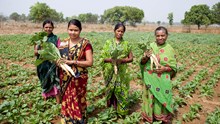
As climate change continues to impact agricultural productivity, the need for sustainable crops has become more pressing than ever. Karonda (Carissa carandas), an underutilized yet highly resilient fruit, stands out as a valuable crop suited for India's arid and semi-arid regions. This perennial shrub from the Apocynaceae family produces small, berry-like fruits, known as 'Christ Thorn' in English, and by various names in regional languages. Thriving in harsh environmental conditions, Karonda offers a wealth of culinary uses, health benefits, and economic opportunities, particularly for tribal and underserved communities.
Key Features of Karonda
Karonda is a robust shrub with dense thorny branches, making it a natural choice for bio-fencing and ornamental hedges. This fruit is small white and greenish at the immature stage, which eventually ripens to pink and deep red. The fruits are acidic in taste, so they are used widely in preparing pickles, jams, jellies, and squashes. Although Karonda was initially available only in the wild throughout India, this crop is now being domesticated and cultivated on a large scale, especially in places that experience less rainfall and have undulated terrains.
This crop has the tolerance to extreme conditions making it suitable for regions affected by climate change. The objective goes beyond agriculture; it provides an important means of nutritional and livelihood security for the tribal populations.
Best Varieties to Choose
Several varieties of Karonda have been developed and released for commercial cultivation. These include:
-
Pant Suvarna, Pant Sudarshan, and Pant Manohar: Best suited for pickling purposes due to their low total soluble solids (TSS).
-
Konkan Bold: A sweet variety with a TSS of 10-12°B, ideal for table consumption.
-
Maru Gaurav: Known for its high yield and superior ascorbic acid content.
-
Thar Kamal: A processing variety with deep red skin and high pulp content.
The choice of variety depends on the intended use, whether for fresh consumption, processing, or value addition.
Geographical Recommendations
It grows well in arid and semi-arid regions, performing well in undulated lands and hilly tracts. Its wild forms are mainly found in states like Chhattisgarh, Madhya Pradesh, Rajasthan, and the Konkan region of Maharashtra. Southern Rajasthan and parts of the Western Ghats are also home to rich Karonda diversity. Backyard plantations and bio-fencing using Karonda are common in rural areas, with tribal populations relying on its fruits for economic and nutritional security.
Production Technology and Practices
Karonda can be propagated through seeds and vegetative methods like hardwood cuttings and air layering. Seeds, obtained from ripe fruits during August-September are sown in a mixture of soil with vermicompost. Hardwood cuttings treated with IBA 500 ppm rooting hormones ensured uniform and faster growth during vegetative propagation.
The plantations are taken up during the monsoon season in pits enriched with organic matter like vermicompost, FYM, and neem cake. Regular pruning ensures the development of a bushy, multi-stem system, which is both aesthetically pleasing and agriculturally productive. The crop flowers between May and June, with fruit harvesting occurring from August to September, depending on the variety and location.
Health Benefits of Karonda
It is a treasure trove of nutrients, particularly iron, ascorbic acid (vitamin C), and various bioactive compounds like phenolics, anthocyanins, and antioxidants. These qualities make it a natural remedy for numerous health issues, including anemia and vitamin C deficiency. Its antiscorbutic, antibacterial, and antifungal properties further enhance its medicinal value, with traditional uses for treating wounds, ulcers, and intestinal worms.
The fruit’s strong antioxidant properties have shown promise in mitigating cardiovascular diseases. This positions Karonda not just as a culinary ingredient but as a nutraceutical powerhouse with immense potential for the health and wellness industry.
Value Addition and Economic Potential
Karonda’s versatility extends to its wide range of processed products. From pickles and chutneys to jams and squashes, its fruits cater to diverse culinary preferences. Mature fruits are often used for pickling and candy preparation, while ripened ones are ideal for juice extraction and jam-making. The high commercial demand for Karonda products, especially jams, has opened avenues for small-scale processing industries.
Tribal communities and SHGs collect, process, and sell fruits and derived products. Here, institutions such as Krishi Vigyan Kendras and NGOs have taken up providing training and marketing support so that economic returns are maximized by growers.
Market value
Fresh Karonda fruits fetch prices ranging from Rs 30-60 per kilogram in local markets. The recent establishment of processing units has further uplifted the economic conditions of tribal populations, who now receive better prices for their produce.
Beyond simply being a resilient fruit, karonda is a representation of economic empowerment, sustainability, and resiliency. Growing crops like Karonda provides a way to ensure livelihoods and preserve natural balance during an uncertain environment. Karonda has the potential to become a staple in India's arid regions because to its strong nutritional profile, versatility, and range of applications, which would be advantageous to both farmers and consumers.
















